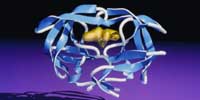

Although quantitative ab initio prediction of binding constants remains a tremendous challenge, a number of qualitative rules for the design of high affinity ligands can be deduced from the many crystal structures of protein-ligand complexes:
- (a) excellent steric and electronic complementarity to the target biomacromolecule is required;
- (b) a fair amount of hydrophobic surface should be buried in the complex for tight binding;
- (c) sufficient conformational rigidity is essential to ensure that the loss of entropy upon ligand binding is acceptable.
At least three additional criteria have to be taken into account in the inhibitor design cycle:
- (d) chemical stability;
- (e) sufficient solubility in water for inhibition tests and structural studies
- (f) ease of synthesis, including the avoidance of chiral centers and of 'dead-end leads' (i.e. compounds which are synthetically not easily amenable to many variations).
Some of these rules and criteria have been incorporated in a number of computer programs for automatic protein structure-based inhibitor design. The methods of these computer programs for protein structure-based ligand design can be grouped as:
- docking,
- linking,
- building.
Only two of these programs came to light in the eighties, but at least ten new programs have been introduced in the last four years. A virtual explosion of methodologies is under way.
Methods for protein structure-based inhibitor design.
![]() Docking algorithms
Docking algorithms
Three different strategies are currently in use for docking ligands on a target protein surface:
- optimal positioning of small chemical entities of molecules,
- the functional groups;
- searching for a subgraph isomorphism in a negative image description of the receptor, and Monte Carlo docking of complete molecules.
1st strategy - GRID.
It places functional groups, called probes, (e.g. amino, carboxylate, methyl moieties) at regularly-spaced lattice points in an active site and evaluates their interaction energy with the protein by means of empirical potential energy functions. Creating ligands from the favorable probe positions is left to the user's inspiration. The use of grids for energy calculations has since been incorporated in other design programs like AUTODOCK, LEGEND, and GroupBuild. Closely related to GRID is MCSS where thousands of copies of functional groups are simultaneously but independently positioned optimally on the protein surface by a molecular dynamics protocol.
2nd strategy - LUDI
First, it describes the protein site of interest in terms of a collection of complementary hydrogen bond donor and acceptor vectors, and lipophilic points, mathematically referred to as a graph. Subsequently, LUDI retrieves matching ligands from a database by a subgraph isomorphism algorithm. This means that the vectors describing the hydrogen bond donor and acceptors, and the lipophilic points of the ligands are fitted optimally onto the graph describing the protein. Other programs use a different description of the protein. CLIX characterizes the site of interest by GRID potential energy maps. DOCK casts a negative image of the receptor as a set of spheres, and essentially therefore performs shape matching. A newer version of this program incorporates a GRID-like energy evaluation which requires charges to be assigned to all atoms of the database ligands. It should be mentioned that the subgraph isomorphism techniques employed in the above programs are not new and are widely used in traditional pharmacophore matching programs like ALLADIN, FOUNDATION, MACCS-3D, ChemDBS-3D, and CATALYST.
3rd strategy -
Metropolis Monte Carlo searching combined with a simulated annealing scheme. Energy evaluations from precalculated GRID-like potential energy maps speed up the procedure. The ligand is kept rigid in the program BOXSEARCH, while AUTODOCK also alters the conformation of the ligand. Flexible ligand docking is computationally very demanding but may become more popular in the future as computing power continues to increase.